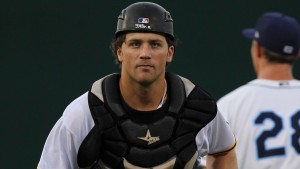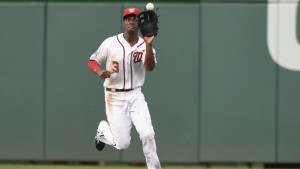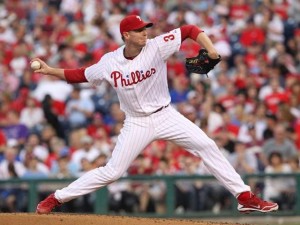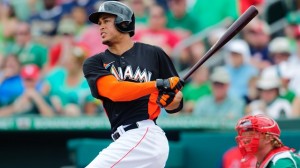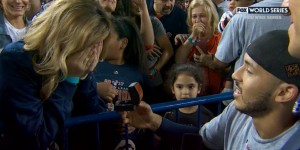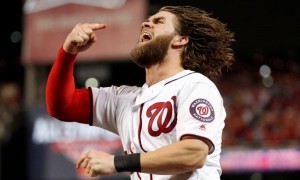
Why do so many people think TRADING Harper is the way to win the 2018 World Series? Photo via fanragsports.com
A nice little surprise just before the Turkey day weekend: an ask Jamal Collier post on mlb.com.
Q: Would you consider trading Harper? I am one of his biggest fans, and I know the desire to win next year, but would the return be worth it in the long run?
A: Forensicane; don’t bother reading this next answer, because you’re not going to like it.
Teams attempting to WIN THE WORLD SERIES in the coming year do not trade their marquee players. Not only that, but teams attempting to win don’t trade one of the best players in the league. \
Not only that, but lets say for the sake of argument that the Nats WERE willing to trade Harper. He’s got one year of control left. He’s set to make north of $20M in 2018. He’s an injury risk. And he’s absolutely going to Free Agency. How much does anyone really think he’ll realistically fetch in trade right now? If he were cost controlled or had multiple years of control left (like an Adam Eaton or a Jonathan Lucroy when he fetched a lot a couple years back) he’d get a kings ransom. But he’s not; he’ll cost a significant portion of a team’s payroll in 2018 and gets just one year of service.
And then there’s this: why does anyone think this ownership group will trade him?? For many years, we’ve asked why the Angels hold on to Mike Trout and “waste” his talents on a sub-.500 team. The answer is always the same: the owner in Los Angeles doesn’t want to move his marquee asset. Why does anyone think that the Lerner group isn’t thinking the same thing? Baseball is still relatively “new” in this town, still fighting it out for the casual sports fan. What kind of message does it send to the casual fan base if you move your most marketable asset? Who else on the Nats is getting goofy TV spots with national telecom companies?
So, no, the team isn’t trading Harper, nor should they. Instead they should be doing *everything* they can to win in 2018 before he (and many others) walk out the door. And (lets not forget), while I think its a certainty that Harper is in NY or LA in 2019 … we also were pretty sure Stephen Strasburg was heading out the door too, so you just never know.
Collier also expresses similar exasperation at the number of these questions he’s getting, then re-iterates many of the arguments above.
Q: You don’t list Adam Lind as a possible signee. Why not? Is it that Brian Goodwin can fill that role … but who is the backup first baseman?
A: I think Lind could resign … similarly to the way that Stephen Drew thought he could parlay his successful 2016 into a starting gig for 2017, Lind probably thinks the same. Finding veteran bat-only beefy 1B/PH types on the open market is not tough; the Nats have specialized in this for years. So they’ll do what they always have done; wait out the market, sign someone on the cheap later in the off-season if they get desperate, or otherwise have a cattle call in spring training for the backup bench bat.
Its worth noting that, much like one-year relievers, sometimes you catch lightning in a bottle with your pinch hitters and its worth cutting bat early, not later. Consider some of the year over year stat lines for our primary bench bats recently:
- Adam Lind: great in 2017 (.303/.362/.513): can he repeat that in 2018?
- Clint Robinson: awesome in 2015 (.272/.358/.424), then awful in 2016 (.235/.305/.332)
- Chris Heisey: adequate in 2016 (.216/.290/.446), then fell off a cliff in 2017 (.162/.215/.270)
- Tyler Moore: fantastic in 2012 (.263/.327/.513), then a combined .216/.264/.362 over PT roles the next three seasons before finally getting cut loose.
- Chad Tracy: good in 2012 (.269/.343/.441), then not so good in 2013 (.202/.243/.326)
And some of these guys never even had a “good” season (ahem, Matt Stairs).
So, perhaps the smart thing to do is to let Lind go (as well as Albers for similar reasons) and try some one new.
Goodwin as a backup 1B?? No, that doesn’t make a ton of sense (he’s only 6’0″ and is an outfielder by trade), but he could feature as a backup outfielder easily enough. Honestly, the “backup 1B” if Ryan Zimmerman goes down for any length of time probably is Daniel Murphy, with his position getting covered by Wilmer Difo.
Collier notes that it was the Nats who declined their part of the $5M mutual option, which somewhat surprised me honestly. I would have thought it would have been the player to decline that and shoot for something more. Nonetheless, it makes the odds of a reunion a bit lower.
Q: Can you do a bit of an explainer about the new luxury tax rules, where Nats are with respect to threshold right now, and how that’ll inform Rizzo’s offseason (speculating anyway)?
A: Without going into it in great detail (I have a post about Nats payroll coming soon), right now as we stand I have the Nats 2018 payroll at about $170M in “real dollars” (counting arb estimates and deferred payments), but about $10M higher in the eyes of MLB’s luxury tax calculators thanks to the Strasburg and Scherzer deals. The team broached $190m with last season’s mid-season transactions and thus became a luxury tax spender for the first time (which will cost them significantly if they were to go after a QO-attached free agent, not that I think they will).
The luxury tax threshold for 2018 is $197M (see this wikipedia page for the link and figures). So, I suppose the team has about $17M or so of “wiggle room” for transactions this off-season plus next mid-season. That isn’t a lot, and all the high-priced players on our payroll are either key pieces or immovable (thanks Matt Wieters). So unless they swing a huge salary, or trade some young assets in payroll-offsetting moves, I think the team will do very little this off-season.
Collier notes similar sentiments.
Q: Last year, the four top outfielders were out due to injuries for extensive periods of time. Shouldn’t they have six top-notch outfielders to draw from next year?
A: Easy to say in theory, harder in practice. You generally only care 4 or perhaps 5 outfielders on a 25-man roster … so how do you make an argument to your 5th and 6th “top-notch” outfielders that they have to hang out in Syracuse for half the season until they’re needed? Not to mention options statuses, 5-year veteran limitations and other things that get in the way of stuff like this. This isn’t the 1950s when you could just stash players all over without regard to service time issues.
No, the better way to go is to have your named starters, then depend on your prospect depth to cover things. And honestly, that’s kinda where the Nats are. Going into 2018 without any moves, you’re looking at:
- Starting OF of Eaton, Taylor and Harper.
- 4th and 5th outfielders Goodwin and Stevenson, both prospects that we developed and being paid the MLB min.
- 6th outfielder in the name of Victor Robles, who is just one of the best prospects in the game.
- 7th and further depth still with the likes of Bautista or perhaps the Cuban Yadiel Hernandez who is 30 and could be closer than we think. We have Jose Marmolejos on the roster still; couldn’t he fill in at LF even if he’s primarily a 1B? And then there’s further-away prospects like Daniel Johnson, who hit pretty well between Low-A and High-A, seems like he’ll start in AA in 2018 and might push his way up.
That’s not too bad. Btw, how good defensively is our OF projected to be in 2018? Eaton at a corner in 2016 was one of the best in the majors, Harper has consistently been a positive-metric fielding RF with one of the best arms in the game, and Taylor just showed how statistically he rivaled the best defensive center fielders in the game. You can’t discount this fact, and it will show itself next year as more fly balls are turned into outs.
Collier likes where our OF depth is.
Q: Why should we believe in Dave Martinez? What makes him different ?
A: I have not weighed in on the manager selection yet. I thought firing Dusty Baker was a mistake, and that the team did not need to break in a new manager in the critical transition year of 2018.
Nonetheless, Martinez does click some boxes for me; he was a successful player with a long career and can command respect from even the veterans on this team. He may not have direct managerial experience, but 10 years as Joe Maddon‘s bench coach is nothing to shake a stick at. He had interviewed for vacancies for years, and deserved a shot. Details of his contract show that he’s severely under-paid and this probably factored into the team’s decision to hire him (for whatever reason, this team remains “cheap” at the manager’s position), but I think he can do the job.
What makes him different? Well, he’s clearly learned the “ropes” of managing underneath the game’s best, and in that position he would have had many opportunities to evaluate Maddon’s decisions, privately decide what he would have done, and then seen how things play out. So he should be able to take the best of what the Cubs are doing and augment those experiences with those opinions he had that were not necessarily taken but which he believed were right. I’m hopeful that his regime will go well.
Collier notes the points above, but also very fairly says that in reality we have no idea how he’ll manage here since he’s never done so before.
